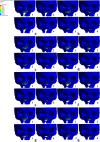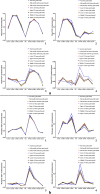Three-dimensional finite element analysis of the effect of alveolar cleft bone graft on the maxillofacial biomechanical stabilities of unilateral complete cleft lip and palate
- PMID: 35596229
- PMCID: PMC9123812
- DOI: 10.1186/s12938-022-01000-y
Three-dimensional finite element analysis of the effect of alveolar cleft bone graft on the maxillofacial biomechanical stabilities of unilateral complete cleft lip and palate
Abstract
Background: The objective is to clarify the effect of alveolar cleft bone graft on maxillofacial biomechanical stabilities, the key areas when bone grafting and in which should be supplemented with bone graft once bone resorption occurred in UCCLP (unilateral complete cleft lip and palate).
Methods: Maxillofacial CAD (computer aided design) models of non-bone graft and full maxilla cleft, full alveolar cleft bone graft, bone graft in other sites of the alveolar cleft were acquired by processing the UCCLP maxillofacial CT data in three-dimensional modeling software. The maxillofacial bone EQV (equivalent) stresses and bone suture EQV strains under occlusal states were obtained in the finite element analysis software.
Results: Under corresponding occlusal states, the EQV stresses of maxilla, pterygoid process of sphenoid bone on the corresponding side and anterior alveolar arch on the non-cleft side were higher than other maxillofacial bones, the EQV strains of nasomaxillary, zygomaticomaxillary and pterygomaxillary suture on the corresponding side were higher than other maxillofacial bone sutures. The mean EQV strains of nasal raphe, the maximum EQV stresses of posterior alveolar arch on the non-cleft side, the mean and maximum EQV strains of nasomaxillary suture on the non-cleft side in full alveolar cleft bone graft model were all significantly lower than those in non-bone graft model. The mean EQV stresses of bilateral anterior alveolar arches, the maximum EQV stresses of maxilla and its alveolar arch on the cleft side in the model with bone graft in lower 1/3 of the alveolar cleft were significantly higher than those in full alveolar cleft bone graft model.
Conclusions: For UCCLP, bilateral maxillae, pterygoid processes of sphenoid bones and bilateral nasomaxillary, zygomaticomaxillary, pterygomaxillary sutures, anterior alveolar arch on the non-cleft side are the main occlusal load-bearing structures before and after alveolar cleft bone graft. Alveolar cleft bone graft mainly affects biomechanical stabilities of nasal raphe and posterior alveolar arch, nasomaxillary suture on the non-cleft side. The areas near nasal floor and in the middle of the alveolar cleft are the key sites when bone grafting, and should be supplemented with bone graft when the bone resorbed in these areas.
Keywords: Alveolar cleft bone graft; Equivalent strain; Equivalent stress; Maxillofacial bone; Maxillofacial bone suture; Unilateral complete cleft lip and palate.
© 2022. The Author(s).
Conflict of interest statement
There are no competing interests in the research.
Figures






Similar articles
-
The comparison of biomechanical effects of the conventional and bone-borne palatal expanders on late adolescence with unilateral cleft palate: a 3-dimensional finite element analysis.BMC Oral Health. 2022 Dec 13;22(1):600. doi: 10.1186/s12903-022-02640-1. BMC Oral Health. 2022. PMID: 36514035 Free PMC article.
-
Effects of cleft type, facemask anchorage method, and alveolar bone graft on maxillary protraction: a three-dimensional finite element analysis.Cleft Palate Craniofac J. 2012 Mar;49(2):221-9. doi: 10.1597/10-265. Epub 2011 Jul 8. Cleft Palate Craniofac J. 2012. PMID: 21740169
-
Biomechanical effects on maxillary protraction of the craniofacial skeleton with cleft lip and palate after alveolar bone graft.J Craniofac Surg. 2013 Mar;24(2):446-53. doi: 10.1097/SCS.0b013e31826cfe27. J Craniofac Surg. 2013. PMID: 23524712
-
Osteoplasty of the alveolar cleft defect.Adv Clin Exp Med. 2012 Mar-Apr;21(2):255-62. Adv Clin Exp Med. 2012. PMID: 23214291 Review.
-
Secondary alveolar bone grafting using autologous versus alloplastic material in the treatment of cleft lip and palate patients: systematic review and meta-analysis.Prog Orthod. 2019 Feb 11;20(1):6. doi: 10.1186/s40510-018-0252-y. Prog Orthod. 2019. PMID: 30740615 Free PMC article.
Cited by
-
Biomechanical effects of a new crimpable gate spring combined with conventional rectangular archwires for torque adjustment of individual anterior teeth : A comparative finite element study.J Orofac Orthop. 2024 Oct 8. doi: 10.1007/s00056-024-00554-x. Online ahead of print. J Orofac Orthop. 2024. PMID: 39377793 English.
-
Finite element analysis of maxillary orthodontic therapies with variable alveolar bone grafts under occlusal forces in patient with unilateral cleft lip and palate.Front Bioeng Biotechnol. 2024 Nov 5;12:1448286. doi: 10.3389/fbioe.2024.1448286. eCollection 2024. Front Bioeng Biotechnol. 2024. PMID: 39564103 Free PMC article.
-
The three-dimensional finite element model of unilateral complete cleft lip and palate and mechanical analysis of the oral surfaces.Maxillofac Plast Reconstr Surg. 2025 Mar 5;47(1):6. doi: 10.1186/s40902-024-00452-7. Maxillofac Plast Reconstr Surg. 2025. PMID: 40042749 Free PMC article.
-
A novel cone beam-CT approach for quantifying maxillary changes following secondary alveolar bone grafting in unilateral cleft patients.BMC Oral Health. 2025 Feb 23;25(1):292. doi: 10.1186/s12903-025-05666-3. BMC Oral Health. 2025. PMID: 39988685 Free PMC article.
References
MeSH terms
Grants and funding
LinkOut - more resources
Full Text Sources
Medical
Miscellaneous

